Introduction
Mandibles ("jaws") are a crucial tool for many insects, but perhaps in no insect group are they more highly utilized than in the ants (Formicidae). Ants use their mandibles for a diverse array of activities, and are thus constrained by the need to have mandibles which can fulfill a number of functions. Despite these constraints, ants have evolved a spectacular diversity of mandible shapes. This page describes and illustrates just a small sampling of this diversity. It begins with a description of the basic roles that mandibles play in the daily lives of ants. It then goes on to describe the basic morphology of an ant mandible and to show a few examples of both typical and somewhat unusual mandibles. The remaining sections (not yet developed) will describe further variations on the basic pattern, including mandibles specialized for prey capture, mandibular variation within a colony (allometric growth and caste systems, for example in the army ants), and mandibles specialized for warfare.
Role of Mandibles
Manipulation of objects
Like most insects, ants lack grasping forelegs (such as those found in the Mantodea and Mantispidae) and compensate for this by using their mandibles as "hands." Ants use their mandibles to manipulate all sorts of objects, such as food particles of varying sizes (from very small to many times larger and heavier than the ant itself) and even liquids (e.g. water or honeydew suspended as a drop between the mandibles). Like other social insects, ants construct often elaborate nests, using their mandibles to dig into dirt or wood, and then again to carry the debris away. In contrast with most other social insects, however, ants have a system of cooperative brood care in which eggs and larvae are directly handled by attending workers. Attendants ("nurses") frequently move the brood to other nest chambers, for example in response to changes in humidity, damage to the nest, the presence of pathogens, or continued development of the brood. (Termites lack a larval stage, while the brood of most social wasps and bees develop in nest cells and are less frequently handled or moved than in ants.) Another fascinating use of mandibles in some ants is social carrying, in which one worker will physically carry another worker in its mandibles to aid in recruitment to a food source or new nest site.
Food processing
In addition to being used to transport food items, mandibles are also used to process the food. Carnivorous ants often use their mandibles to decapitate or dismember their prey, to facilitate feeding or storage. They also use their mandibles to tear, puncture, or grind their food.
Hunting and defense
Mandibles are also crucial to the hunting success of predatory ants. Mandibles can be wielded as formidable weapons in their own right, or as tools with which to grasp prey until a paralyzing sting can be delivered (a common strategy in the Ponerinae, most of which are solitary predators). Mass foraging predators (e.g. army ants, described below) use their mandibles to pin down prey from all sides while their nestmates dispatch it. A number of highly modified mandibles have evolved in response to the requirements of catching certain prey, especially those that are otherwise difficult to catch (e.g. collembolans). See the section on specialized predators below for several examples of such modifications.
Despite a common misconception, most ants lack painful bites (being too small to have any effect on human skin). Usually ant "bites" are actually the venomous stings of ants in certain subfamilies (most commonly the Myrmicinae, but also members of the Ponerinae, Myrmeciinae, Pseudomyrmecinae, and others, and perhaps most notoriously the bullet ant, Paraponera clavata). Some ants, however, can indeed inflict a painful bite on humans; among these are the African driver ants of the subfamily Dorylinae, which in great numbers are capable of killing large mammals solely through the action of their mandibles (Hölldobler and Wilson, 1990). Perhaps more important generally is the role of mandibles in defense against smaller predators and competitors, such as other ants. Many ants have a major worker caste ("soldiers") with large body size and massive mandibles (e.g. Eciton and Pheidole, described below). Such major workers can be truly formidable adversaries to their opponents. Some ants have evolved mandibles specialized for offense against other ants, including Polyergus, a genus of slave-making ants which uses its sickle-like mandibles to maim or kill Formica workers defending their brood (see below).
Basic Morphology
Ant Mouthparts
The basic mouthparts of insects include (from anterior to posterior) the labrum (upper lip), paired mandibles, paired maxillae, and the labium (lower lip) (Chapman, 1998). Both the maxillae and labium have sensory palps; the number of palp articles ("segments") are important characters in the identification of ant genera. The primitive condition in ants is believed to be 6-segmented maxillary palps and 4-segmented labial palps (written "6, 4"), but this number has frequently become reduced during the evolution of various ant lineages (Bolton, 2003). In addition, in some ants (e.g. Myrmecocystus) certain palp articles have become greatly elongated.
Typical Ant Mandibles
Like all pterygote insects, ant mandibles have two points of articulation with the head (such mandibles are termed "dicondylic") and are thus constrained to move transversely (Triplehorn and Johnson, 2005). A typical ant mandible is illustrated in Fig. 1. It is characterized by an outer, external margin (Fig. 1a) and an internal margin, which is further divided by the basal angle (Fig. 1d) into a basal margin (Fig. 1c) and a masticatory margin (Fig. 1b). From the masticatory margin arise a variable number of teeth and denticles (Fig. 1e).


Figure 1. Mandible of Hagensia havilandi (Ponerinae; South Africa), illustrating the basic external morphology of an ant mandible (points of articulation with the head not shown). a: external margin; b-e: parts of the internal margin: b: masticatory margin; c: basal margin; d: basal angle; e: teeth. Note the long transverse groove extending much of the length of the mandible; similar grooves and pits occur on the mandibles of many ants. Note also the row of setae along the masticatory border, another common feature of ant mandibles. Image copyright 2004 Chris A. Schmidt.
Ants primitively had short, curved mandibles with two teeth (apical and pre-apical) (Bolton, 2003). While many modern ants have basically this same mandibular morphology (although usually with additional teeth), a more typical groundplan is for the mandible to have an elongated masticatory margin and a prominent basal angle, giving the mandible a distinctive triangular shape. This type of mandible is illustrated in Figures 2-4, which show frontal views of three ants from distantly-related subfamilies.

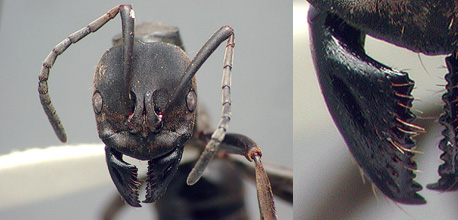
Figure 2. Frontal view (left) and enlarged view of mandible (right) of Hagensia havilandi (Ponerinae; South Africa), showing the characteristic triangular mandibular morphology common to many ants. Photograph copyright 2004 Chris A. Schmidt.
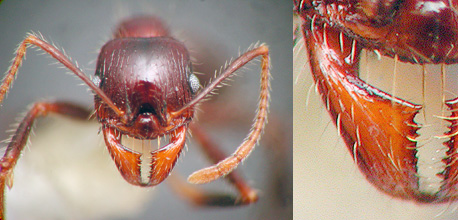
Figure 3. Frontal view (left) and enlarged view of mandible (right) of a minor worker of Pheidole rhea (Myrmicinae; Arizona, USA), again showing the characteristic triangular mandibular morphology. The major worker of this species is illustrated below in the section on polyphenisms. Photograph copyright 2004 Chris A. Schmidt.
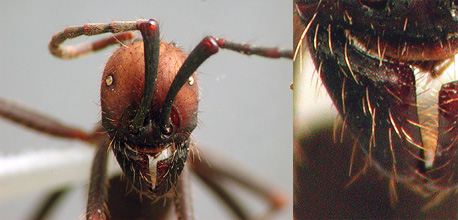
Figure 4. Frontal view (left) and enlarged view of mandible (right) of a media worker of Eciton sp. (Ecitoninae; Costa Rica), a Neotropical army ant. The major worker of this species has highly modified mandibles and is illustrated below in the section on polyphenisms. Photograph copyright 2004 Chris A. Schmidt.
Unusual Ant Mandibles
Two variations on this basic pattern are illustrated in Figures 5 and 6. Ectatomma tuberculatum (Fig. 5) has especially large mandibles, in which the masticatory margin has become greatly lengthened, and is lacking noticeable teeth except for at the apices. In contrast, the Amblyoponinae (illustrated here by Amblyopone pallipes, Fig. 6) have long, straight mandibles lacking distinct basal and masticatory margins. In at least some species (including A. pallipes), certain teeth are pronged, with two points. Additional variations in mandibular morphology are described in the following sections.

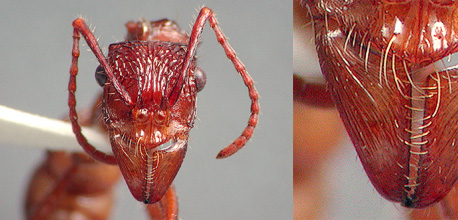
Figure 5. An example of variation on the basic mandibular form, Ectatomma tuberculatum (Ectatomminae; Costa Rica). Its masticatory margins are greatly lengthened and nearly toothless. Photograph copyright 2004 Chris A. Schmidt.
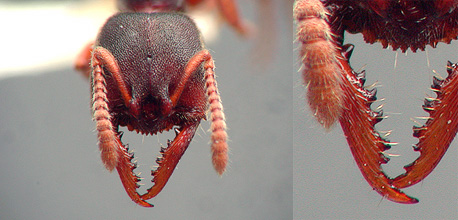
Figure 6. Another example of mandibular variation, Amblyopone pallipes (Amblyoponinae; North Carolina, USA), whose mandibles lack a distinct basal angle and whose numerous teeth have an unusual forked appearance. Note also the row of clypeal teeth between the mandibles, a synapomorphy of this subfamily. Photograph copyright 2004 Chris A. Schmidt.

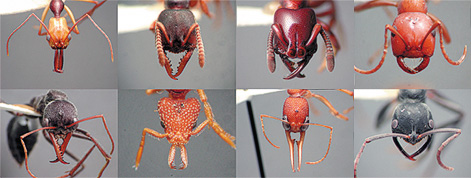
 This page is part of the project "New Strategies for Life Sciences Outreach in
Arizona: Developing a Digital Library of Audio and Video Features in the
Context of the Tree of Life Web Project" funded by the “Anyplace
Access for Arizonans” Initiative under the
This page is part of the project "New Strategies for Life Sciences Outreach in
Arizona: Developing a Digital Library of Audio and Video Features in the
Context of the Tree of Life Web Project" funded by the “Anyplace
Access for Arizonans” Initiative under the 



 Go to quick links
Go to quick search
Go to navigation for this section of the ToL site
Go to detailed links for the ToL site
Go to quick links
Go to quick search
Go to navigation for this section of the ToL site
Go to detailed links for the ToL site